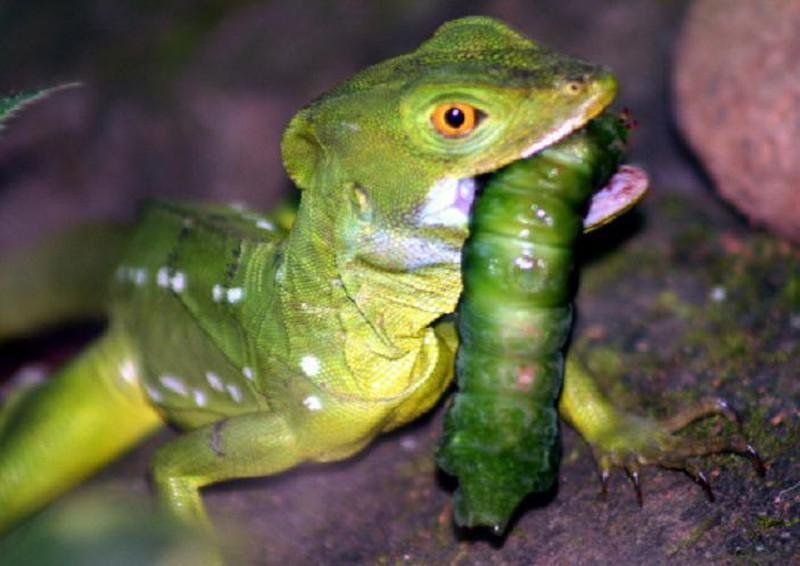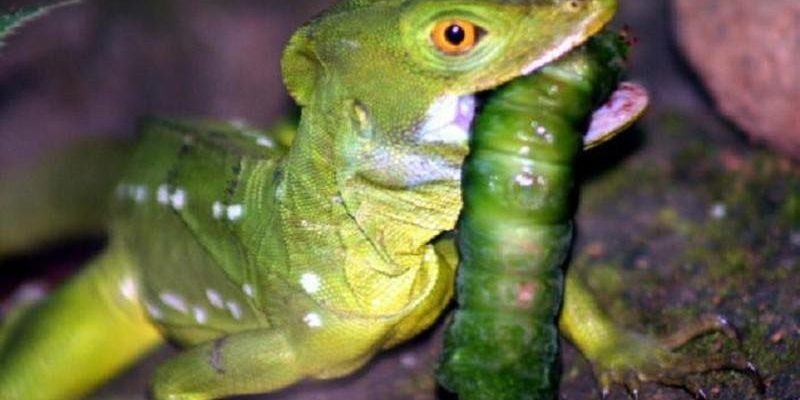
Basilisk lizards are native to Central and South America, where they often bask in the sun and soak up the vibrant environment around them. With their unique adaptations, they face challenges every day, ensuring they survive and thrive in their habitats. Let’s dive deeper into their diet and hunting strategies, making sense of how this remarkable lizard manages to navigate its world.
Diet of the Basilisk Lizard
Basilisk lizards are omnivores, which means they eat a mix of both plants and animals. Their diet varies based on their habitat and the time of year. You might find them munching on various fruits, insects, and even small vertebrates. Here’s a closer look at what’s on their menu:
- Insects: These lizards are big fans of insects like crickets, beetles, and grasshoppers. Insects provide the protein needed for growth and energy.
- Fruits and Vegetation: Basilisks often snack on leaves, flowers, and fruits. They particularly enjoy berries and other small fruits, adding some sweetness to their diet.
- Small Animals: Sometimes, these agile hunters will go after small reptiles, amphibians, or even young birds. It’s all about taking advantage of what’s available in their environment.
In the wild, the basilisk lizard’s diet can change seasonally. For instance, during the rainy season, when insects are more abundant, they may focus more on catching bugs. This varied diet helps them adapt to changes in habitat and food availability, which is crucial for survival.
How Basilisk Lizards Hunt
You might be wondering how these lizards manage to catch their food, given their relatively small size. Here’s the thing: basilisk lizards have developed some clever techniques for hunting that make them quite effective predators.
One of their most notable skills is their ability to run on water. Yes, you read that right! With their long, powerful legs and unique foot structure, they can sprint across the surface of the water to escape predators or to chase after prey. This remarkable adaptation is a game-changer in their hunting strategies.
When hunting, they often use a combination of stealth and speed. They might start by observing their surroundings, waiting patiently for an unsuspecting insect or small critter to come into view. Once they spot something, they can make a quick dash. Their speed helps them outpace their prey and catch it before it has a chance to escape.
Unique Hunting Techniques
Aside from their water-running prowess, basilisk lizards have a few other tricks up their sleeves. Their agility allows them to navigate through trees and vegetation with ease, making them excellent at hunting in their jungle environments. They often rely on their surroundings for cover, waiting until the right moment to strike.
- Ambush Techniques: By blending into their surroundings, basilisk lizards can surprise unsuspecting prey. This method relies on patience, as they may stay still for quite a while.
- Active Pursuit: When they need a quick meal, basilisk lizards might chase after insects or small animals, using their impressive speed and agility to catch them.
These hunting techniques demonstrate the basilisk’s adaptability, allowing it to thrive in various environments. Their skills are honed by nature and necessity, showcasing how creatures evolve over time to ensure their survival.
The Role of Vision in Hunting
Another fascinating aspect of the basilisk lizard’s hunting ability is its exceptional vision. These lizards have large eyes that provide a wide field of view, enabling them to spot potential food or danger from afar.
The sensitivity of their vision helps them differentiate between different colors and movements. This sharp eyesight is crucial when they’re trying to locate insects among the leaves or watch for predators that might be lurking nearby.
Sometimes, you might find a basilisk lizard perched on a branch, scanning the area as if it’s on a lookout. It’s almost like they’re waiting for the perfect moment to pounce—ready to make their move when the opportunity arises.
Challenges in Finding Food
While basilisk lizards have developed impressive hunting skills, they still face challenges when it comes to food. One of the biggest threats is habitat loss due to human activities like deforestation and urban development. As their homes shrink, so does their access to food.
Additionally, competition with other species can make finding a meal more difficult. In areas where numerous predators are vying for the same food, they need to be strategic in their hunting.
Understanding these challenges gives us a glimpse into the pressures basilisk lizards face in their natural environments. Conservation efforts are vital to ensure that these incredible creatures can continue to thrive and hunt as they have for centuries.
The basilisk lizard is an extraordinary example of how nature crafts unique adaptations for survival. From their varied diet of insects, fruits, and small animals to their incredible hunting techniques like running on water and ambush tactics, these lizards have mastered the art of living in their environments.
By understanding what the basilisk lizard eats and how it hunts, we gain insight into the delicate balance of ecosystems. Protecting their habitats and ensuring their survival is crucial, as they play a unique role in their environments. So, the next time you hear about the Jesus Christ lizard, remember that there’s so much more to discover about this fascinating creature and its daily adventures in the jungle!

